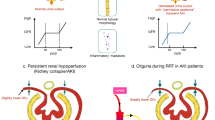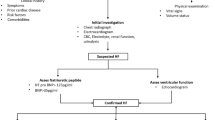Abstract
Background
Typical hemolytic uremic syndrome (HUS) causes acute kidney injury (AKI) and serious sequelae of chronic kidney disease (CKD) in some. Hyperuricemia is a common finding in typical HUS that may contribute to kidney damage. We explored whether aggressive management of hyperuricemia with rasburicase could improve outcomes in AKI patients with typical HUS.
Methods
We retrospectively analyzed medical records of children with typical HUS admitted to a tertiary center between 2005 and 2017. We compared clinical outcomes of hospitalization and 1-year post-discharge between those with rasburicase treatment (n = 13) and those without (controls, n = 29).
Results
With rasburicase treatment, hyperuricemia corrected more rapidly (median 36 vs. 120 h, p < 0.001), and hospital stays were shorter (median 9 vs. 12 days, p = 0.003) than in the controls. There was no difference in dialysis requirement. At 1-year post-discharge, the proportion of patients with impaired kidney function (estimated glomerular filtration rate < 90 mL/min/1.73 m2) was lower in the rasburicase group (7.7% vs. 41.4%, p = 0.036) than in the controls. Hypertension and proteinuria tended to be more common in the controls than in the rasburicase group. Collectively, long-term renal sequelae of impaired kidney function, proteinuria, or hypertension at a 1-year follow-up was less common in the rasburicase group than in the controls (7.7% vs. 62.1%; p = 0.001).
Conclusions
Children with typical HUS treated with rasburicase had shorter hospital stays and less long-term sequelae at 1-year post-discharge than those who were not treated with rasburicase. These results support the use of rasburicase to prevent CKD in pediatric patients with typical HUS-associated AKI.

Graphical Abstract


Similar content being viewed by others
References
Tarr PI, Gordon CA, Chandler WL (2005) Shiga-toxin-producing Escherichia coli and haemolytic uraemic syndrome. Lancet 365:1073–1086
Gould LH, Demma L, Jones TF, Hurd S, Vugia DJ, Smith K, Shiferaw B, Segler S, Palmer A, Zansky S, Griffin PM (2009) Hemolytic uremic syndrome and death in persons with Escherichia coli O157:H7 infection, foodborne diseases active surveillance network sites, 2000-2006. Clin Infect Dis 49:1480–1485
Khalid M, Andreoli S (2019) Extrarenal manifestations of the hemolytic uremic syndrome associated with Shiga toxin-producing Escherichia coli (STEC HUS). Pediatr Nephrol 34:2495–2507
Rosales A, Hofer J, Zimmerhackl LB, Jungraithmayr TC, Riedl M, Giner T, Strasak A, Orth-Holler D, Wurzner R, Karch H (2012) Need for long-term follow-up in enterohemorrhagic Escherichia coli-associated hemolytic uremic syndrome due to late-emerging sequelae. Clin Infect Dis 54:1413–1421
Percheron L, Gramada R, Tellier S, Salomon R, Harambat J, Llanas B, Fila M, Allain-Launay E, Lapeyraque AL, Leroy V, Adra AL, Berard E, Bourdat-Michel G, Chehade H, Eckart P, Merieau E, Pietrement C, Sellier-Leclerc AL, Fremeaux-Bacchi V, Dimeglio C, Garnier A (2018) Eculizumab treatment in severe pediatric STEC-HUS: a multicenter retrospective study. Pediatr Nephrol 33:1385–1394
Pape L, Hartmann H, Bange FC, Suerbaum S, Bueltmann E, Ahlenstiel-Grunow T (2015) Eculizumab in typical hemolytic uremic syndrome (HUS) with neurological involvement. Medicine (Baltimore) 94:e1000
Kaplan BS, Thomson PD (1976) Hyperuricemia in the hemolytic-uremic syndrome. Am J Dis Child 130:854–856
O'Regan S, Rousseau E (1988) Hemolytic uremic syndrome: urate nephropathy superimposed on an acute glomerulopathy? An hypothesis. Clin Nephrol 30:207–210
Ejaz AA, Mu W, Kang DH, Roncal C, Sautin YY, Henderson G, Tabah-Fisch I, Keller B, Beaver TM, Nakagawa T, Johnson RJ (2007) Could uric acid have a role in acute renal failure? Clin J Am Soc Nephrol 2:16–21
Fathallah-Shaykh SA, Cramer MT (2014) Uric acid and the kidney. Pediatr Nephrol 29:999–1008
Brant JM (2002) Rasburicase: an innovative new treatment for hyperuricemia associated with tumor lysis syndrome. Clin J Oncol Nurs 6:12–16
Goldman SC, Holcenberg JS, Finklestein JZ, Hutchinson R, Kreissman S, Johnson FL, Tou C, Harvey E, Morris E, Cairo MS (2001) A randomized comparison between rasburicase and allopurinol in children with lymphoma or leukemia at high risk for tumor lysis. Blood 97:2998–3003
Alakel N, Middeke JM, Schetelig J, Bornhauser M (2017) Prevention and treatment of tumor lysis syndrome, and the efficacy and role of rasburicase. Onco Targets Ther 10:597–605
Zhang B, Lee AI, Podoltsev N (2014) Tumor lysis syndrome and acute anemia in an African-American man with chronic lymphocytic leukemia. Oxf Med Case Rep 2014:138–140
Pui CH, Mahmoud HH, Wiley JM, Woods GM, Leverger G, Camitta B, Hastings C, Blaney SM, Relling MV, Reaman GH (2001) Recombinant urate oxidase for the prophylaxis or treatment of hyperuricemia in patients With leukemia or lymphoma. J Clin Oncol 19:697–704
Lin PY, Lin CC, Liu HC, Lee MD, Lee HC, Ho CS, Chiu NC, Peng CC, Huang FY, Tsai JD (2011) Rasburicase improves hyperuricemia in patients with acute kidney injury secondary to rhabdomyolysis caused by ecstasy intoxication and exertional heat stroke. Pediatr Crit Care Med 12:e424–e427
Hobbs DJ, Steinke JM, Chung JY, Barletta GM, Bunchman TE (2010) Rasburicase improves hyperuricemia in infants with acute kidney injury. Pediatr Nephrol 25:305–309
Acosta AA, Hogg RJ (2012) Rasburicase for hyperuricemia in hemolytic uremic syndrome. Pediatr Nephrol 27:325–329
Balestracci A, Meni Battaglia L, Martin SM, Toledo I (2020) Rasburicase in hemolytic uremic syndrome related to Shiga toxin-producing Escherichia coli: a report of nine cases. Pediatr Nephrol 35:1133–1137
Seltz LB, Bakel LA, Tiehen J, Gao D, Cadnapaphornchai MA, Lum G, Ford D (2012) Efficacy and safety of clopidogrel in children with diarrhea associated hemolytic uremic syndrome. Thromb Res 130:e26–e30
Schwartz GJ, Munoz A, Schneider MF, Mak RH, Kaskel F, Warady BA, Furth SL (2009) New equations to estimate GFR in children with CKD. J Am Soc Nephrol 20:629–637
Lee CG, Moon JS, Choi JM, Nam CM, Lee SY, Oh K, Kim YT (2008) Normative blood pressure references for Korean children and adolescents. Korean J Pediatr 51:33–41
Spinale JM, Ruebner RL, Copelovitch L, Kaplan BS (2013) Long-term outcomes of Shiga toxin hemolytic uremic syndrome. Pediatr Nephrol 28:2097–2105
Jayabose S, Kumar V, Dhanabalan R, Rajan P, Rathnam K, Viswanathan TK (2015) Low-dose rasburicase in hematologic malignancies. Indian J Pediatr 82:458–461
Gopakumar KG, Thankamony P, Seetharam S, Kusumakumary P (2017) Treatment of tumor lysis syndrome in children with leukemia/lymphoma in resource-limited settings-Efficacy of a fixed low-dose rasburicase. Pediatr Hematol Oncol 34:206–211
Schifferli A, von Vigier RO, Fontana M, Sparta G, Schmid H, Bianchetti MG, Rudin C (2010) Hemolytic-uremic syndrome in Switzerland: a nationwide surveillance 1997-2003. Eur J Pediatr 169:591–598
Feig DI (2009) Uric acid: a novel mediator and marker of risk in chronic kidney disease? Curr Opin Nephrol Hypertens 18:526–530
Feig DI (2012) Hyperuricemia and hypertension. Adv Chronic Kidney Dis 19:377–385
Varrier M, Ostermann M (2014) Novel risk factors for acute kidney injury. Curr Opin Nephrol Hypertens 23:560–569
Conger JD (1990) Acute uric acid nephropathy. Med Clin North Am 74:859–871
Rousseau E, Blais N, O'Regan S (1990) Decreased necessity for dialysis with loop diuretic therapy in hemolytic uremic syndrome. Clin Nephrol 34:22–25
Balestracci A, Martin SM, Toledo I (2012) Hyperuricemia in children with post-diarrheal hemolytic uremic syndrome. Pediatr Nephrol 27:1421–1422
Coca SG, Singanamala S, Parikh CR (2012) Chronic kidney disease after acute kidney injury: a systematic review and meta-analysis. Kidney Int 81:442–448
Noble RA, Lucas BJ, Selby NM (2020) Long-term outcomes in patients with acute kidney injury. Clin J Am Soc Nephrol 15:423–429
Vaterodt L, Holle J, Huseman D, Muller D, Thumfart J (2018) Short- and long-term renal outcome of hemolytic-uremic syndrome in childhood. Front Pediatr 6:220
Author information
Authors and Affiliations
Corresponding author
Ethics declarations
The study was approved by the Seoul Nation University Hospital institutional review board (H-1711-012-895). Due to the characteristics of the study, informed consent from the patients was waived.
Conflict of interest
The authors declare that they have no conflict of interest.
Additional information
Publisher’s note
Springer Nature remains neutral with regard to jurisdictional claims in published maps and institutional affiliations.
Electronic supplementary material
ESM 1
(PPTX 47 kb)
Rights and permissions
About this article
Cite this article
Cho, M.H., Ahn, Y.H., Lim, S.h. et al. Rasburicase improves the outcome of acute kidney injury from typical hemolytic uremic syndrome. Pediatr Nephrol 35, 2183–2189 (2020). https://doi.org/10.1007/s00467-020-04644-x
Received:
Revised:
Accepted:
Published:
Issue Date:
DOI: https://doi.org/10.1007/s00467-020-04644-x




